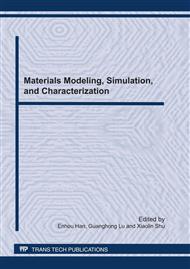p.134
p.144
p.149
p.154
p.159
p.168
p.179
p.184
p.190
Molecular Dynamics Simulation of Anisotropic Corrosion-Induced Stress in Fe Single Crystal
Abstract:
Pipeline steel in soil containing water could induce a macro tensile stress, leading to stress corrosion cracking (SCC). Anisotropic corrosion-induced stress of Fe single crystal is studied by molecular dynamics (MD) in this paper. The surface perpendicular to the z direction is subjected to the corrosion, and the process of corrosion along three crystallographic directions is simulated using MD approach. When the surface with one specific orientation is corroded, two cases are considered: one is that the periodic boundary condition is applied along the x direction, while free boundary condition along the y direction; and the other is that the periodic boundary condition along the y direction, while free boundary condition along the x direction. The results show that both the deflection of the free end and the macro tensile stress of the crystal for the corrosion in three crystallographic orientations are increasing with the increase of the relative depth of the porous layer. The values of the deflection and the macro tensile stress for the two cases depend on the orientation with the free boundary condition when the surface with one specific orientation is corroded. Moreover, the smaller the interplanar spacing along the orientation with the free boundary condition is, the larger the deflection and the macro tensile stress are.
Info:
Periodical:
Pages:
159-167
Citation:
Online since:
June 2011
Price:
Сopyright:
© 2011 Trans Tech Publications Ltd. All Rights Reserved
Share:
Citation:


